the second language acqusition第二语言习得复习资料
- 格式:doc
- 大小:124.00 KB
- 文档页数:14

二语习得理论--中文————————————————————————————————作者:————————————————————————————————日期:ﻩ二语习得定义二语习得理论概述二语习得的关键期二语习得(英语)四个阶段各阶段的教育技巧The definition of second languageacquisitionﻫOverview of Second Language AcquisitionﻫCritical period of second langu age acquisitionSecondlanguage acquisition (English)infour phasesﻫVariousstagesof education skills二语习得理论目录二语习得定义二语习得理论概述二语习得的关键期二语习得(英语)四个阶段各阶段的教育技巧第一阶段:沉默期第二阶段:英语语法干扰期第三阶段:学术英语提高期二语习得定义二语习得理论概述二语习得的关键期二语习得(英语)四个阶段各阶段的教育技巧第一阶段:沉默期第二阶段:英语语法干扰期第三阶段:学术英语提高期•第四阶段:学习曲线上升期展开目录二语习得定义二语习得理论概述二语习得的关键期二语习得(英语)四个阶段各阶段的教育技巧编辑本段二语习得定义1960年代开始,有人研究人们获得语言能力的机制,尤其是获得外语能力的机制,综合了语言学、神经语言学、语言教育学、社会学多种学科,慢慢发展出一门新的学科,叫“二语习得”,Second Language Acquisition。
编辑本段二语习得理论概述自 20 世纪70 年代以来,人们对二语习得从各个不同的方面进行了研究,所运用的研究方法也各具特色。
有的研究侧重于描写 ,有的研究偏重于假设,有的研究则采用实验。
20多年来 ,第二语言的多侧面、多方法的研究格局导致了该领域中的理论层出不穷。
目前较为流行的有:(一)乔姆斯基的普遍语法与二语习得乔姆斯基和其支持者们认为,遗传基因赋予人类普遍的语言专门知识 ,他把这种先天知识称之为“普遍语法”。
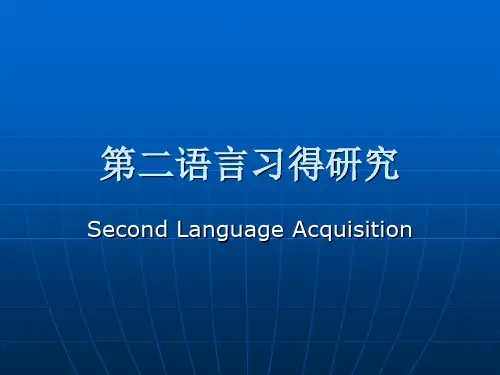
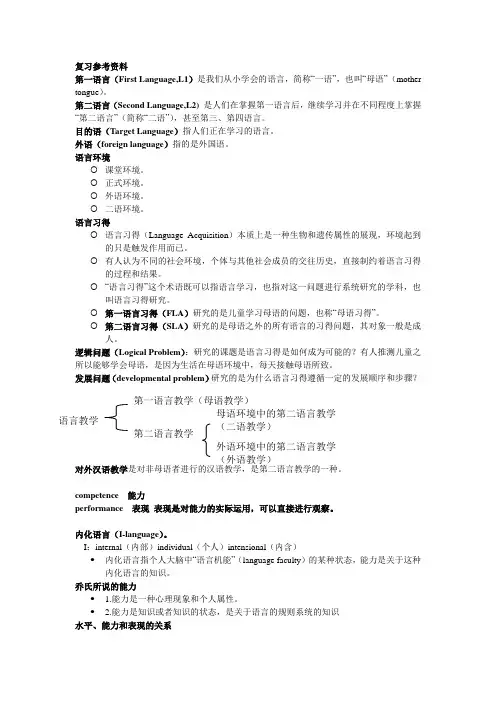
复习参考资料第一语言(First Language,L1)是我们从小学会的语言,简称“一语”,也叫“母语”(mother tongue )。
第二语言(Second Language,L2) 是人们在掌握第一语言后,继续学习并在不同程度上掌握“第二语言”(简称“二语”),甚至第三、第四语言。
目的语(Target Language )指人们正在学习的语言。
外语(foreign language )指的是外国语。
语言环境课堂环境。
正式环境。
外语环境。
二语环境。
语言习得语言习得(Language Acquisition )本质上是一种生物和遗传属性的展现,环境起到的只是触发作用而已。
有人认为不同的社会环境,个体与其他社会成员的交往历史,直接制约着语言习得的过程和结果。
“语言习得”这个术语既可以指语言学习,也指对这一问题进行系统研究的学科,也叫语言习得研究。
第一语言习得(FLA )研究的是儿童学习母语的问题,也称“母语习得”。
第二语言习得(SLA )研究的是母语之外的所有语言的习得问题,其对象一般是成人。
逻辑问题(Logical Problem ):研究的课题是语言习得是如何成为可能的?有人推测儿童之所以能够学会母语,是因为生活在母语环境中,每天接触母语所致。
发展问题(developmental problem )研究的是为什么语言习得遵循一定的发展顺序和步骤? 对外汉语教学是对非母语者进行的汉语教学,是第二语言教学的一种。
competence 能力performance 表现 表现是对能力的实际运用,可以直接进行观察。
内化语言(I-language )。
I :internal (内部)individual (个人)intensional (内含)内化语言指个人大脑中“语言机能”(language faculty )的某种状态,能力是关于这种内化语言的知识。
乔氏所说的能力1.能力是一种心理现象和个人属性。
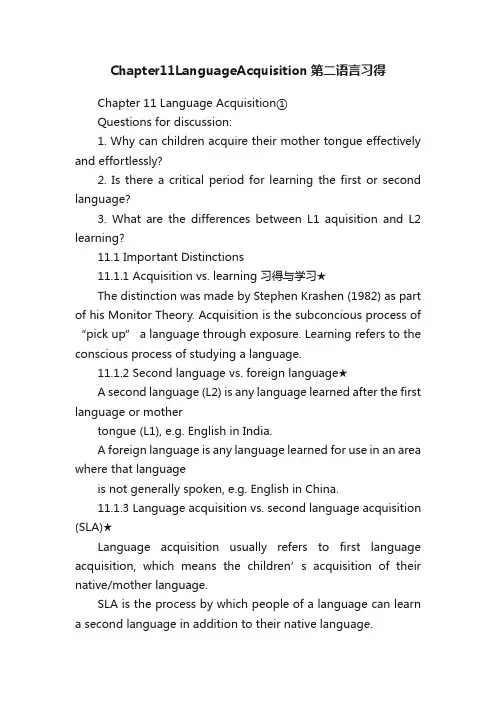
Chapter11LanguageAcquisition第二语言习得Chapter 11 Language Acquisition①Questions for discussion:1. Why can children acquire their mother tongue effectively and effortlessly?2. Is there a critical period for learning the first or second language?3. What are the differences between L1 aquisition and L2 learning?11.1 Important Distinctions11.1.1 Acquisition vs. learning 习得与学习★The distinction was made by Stephen Krashen (1982) as part of his Monitor Theory. Acquisition is the subconcious process of “pick up” a language through exposure. Learning refers to the conscious process of studying a language.11.1.2 Second language vs. foreign language★A second language (L2) is any language learned after the first language or mothertongue (L1), e.g. English in India.A foreign language is any language learned for use in an area where that languageis not generally spoken, e.g. English in China.11.1.3 Language acquisition vs. second language acquisition (SLA)★Language acquisition usually refers to first language acquisition, which means the children’s acquisition of their native/mother language.SLA is the process by which people of a language can learn a second language in addition to their native language.11.2 First Language Acquisition11.2.1 Theories of FLA (also Child Language Acquisition)◆Behaviorism: Language learning is simply a matter of imitation and habit formation.Innatism: Human beings are biologically programmed for language, like walking.(Language Acquisition Device and Universal Grammar)Interactionism: Language develops as a result of the complex interplay between children and the environment, and the modified language (motherese/caretaker talk/child directed speech保姆式语言) is crucial.Questions for discussion:1. How do you think of the three theories about language acquisition?①教材中没有关于language acquisition的独立章节,这里本章内容部分来自课本第六、十一章,其他内容来自其他语言学书。
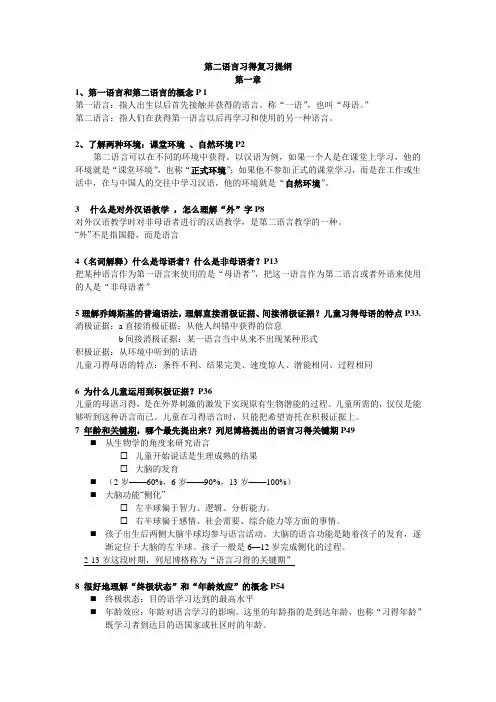
第二语言习得复习提纲第一章1、第一语言和第二语言的概念P 1第一语言:指人出生以后首先接触并获得的语言。
称“一语”,也叫“母语。
”第二语言:指人们在获得第一语言以后再学习和使用的另一种语言。
2、了解两种环境:课堂环境、自然环境P2第二语言可以在不同的环境中获得。
以汉语为例,如果一个人是在课堂上学习,他的环境就是“课堂环境”,也称“正式环境”;如果他不参加正式的课堂学习,而是在工作或生活中,在与中国人的交往中学习汉语,他的环境就是“自然环境”。
3什么是对外汉语教学,怎么理解“外”字P8对外汉语教学时对非母语者进行的汉语教学,是第二语言教学的一种。
“外”不是指国籍,而是语言4(名词解释)什么是母语者?什么是非母语者?P13把某种语言作为第一语言来使用的是“母语者”,把这一语言作为第二语言或者外语来使用的人是“非母语者”5理解乔姆斯基的普遍语法,理解直接消极证据、间接消极证据?儿童习得母语的特点P33. 消极证据:a直接消极证据:从他人纠错中获得的信息b间接消极证据:某一语言当中从来不出现某种形式积极证据:从环境中听到的话语儿童习得母语的特点:条件不利、结果完美、速度惊人、潜能相同、过程相同6 为什么儿童运用到积极证据?P36儿童的母语习得,是在外界刺激的激发下实现原有生物潜能的过程。
儿童所需的,仅仅是能够听到这种语言而已。
儿童在习得语言时,只能把希望寄托在积极证据上。
7 年龄和关键期,哪个最先提出来?列尼博格提出的语言习得关键期P49⏹从生物学的角度来研究语言☐儿童开始说话是生理成熟的结果☐大脑的发育⏹(2岁——60%,6岁——90%,13岁——100%)⏹大脑功能“侧化”☐左半球偏于智力、逻辑、分析能力。
☐右半球偏于感情、社会需要、综合能力等方面的事情。
⏹孩子出生后两侧大脑半球均参与语言活动。
大脑的语言功能是随着孩子的发育,逐渐定位于大脑的左半球。
孩子一般是6—12岁完成侧化的过程。
2-13岁这段时期,列尼博格称为“语言习得的关键期”8 很好地理解“终极状态”和“年龄效应”的概念P54⏹终极状态:目的语学习达到的最高水平⏹年龄效应:年龄对语言学习的影响。
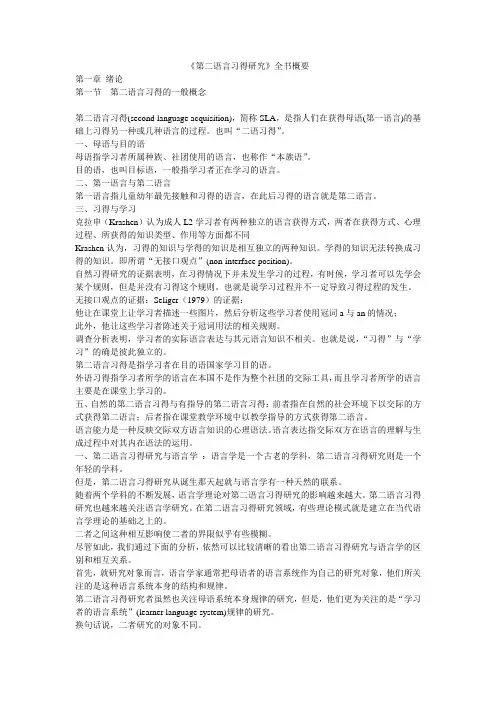
《第二语言习得研究》全书概要第一章绪论第一节第二语言习得的一般概念第二语言习得(second language acquisition),简称SLA,是指人们在获得母语(第一语言)的基础上习得另一种或几种语言的过程。
也叫“二语习得”。
一、母语与目的语母语指学习者所属种族、社团使用的语言,也称作“本族语”。
目的语,也叫目标语,一般指学习者正在学习的语言。
二、第一语言与第二语言第一语言指儿童幼年最先接触和习得的语言,在此后习得的语言就是第二语言。
三、习得与学习克拉申(Krashen)认为成人L2学习者有两种独立的语言获得方式,两者在获得方式、心理过程、所获得的知识类型、作用等方面都不同Krashen认为,习得的知识与学得的知识是相互独立的两种知识。
学得的知识无法转换成习得的知识。
即所谓“无接口观点”(non-interface position)。
自然习得研究的证据表明,在习得情况下并未发生学习的过程,有时候,学习者可以先学会某个规则,但是并没有习得这个规则。
也就是说学习过程并不一定导致习得过程的发生。
无接口观点的证据:Seliger(1979)的证据:他让在课堂上让学习者描述一些图片,然后分析这些学习者使用冠词a与an的情况;此外,他让这些学习者陈述关于冠词用法的相关规则。
调查分析表明,学习者的实际语言表达与其元语言知识不相关。
也就是说,“习得”与“学习”的确是彼此独立的。
第二语言习得是指学习者在目的语国家学习目的语。
外语习得指学习者所学的语言在本国不是作为整个社团的交际工具,而且学习者所学的语言主要是在课堂上学习的。
五、自然的第二语言习得与有指导的第二语言习得:前者指在自然的社会环境下以交际的方式获得第二语言;后者指在课堂教学环境中以教学指导的方式获得第二语言。
语言能力是一种反映交际双方语言知识的心理语法。
语言表达指交际双方在语言的理解与生成过程中对其内在语法的运用。
一、第二语言习得研究与语言学:语言学是一个古老的学科,第二语言习得研究则是一个年轻的学科。
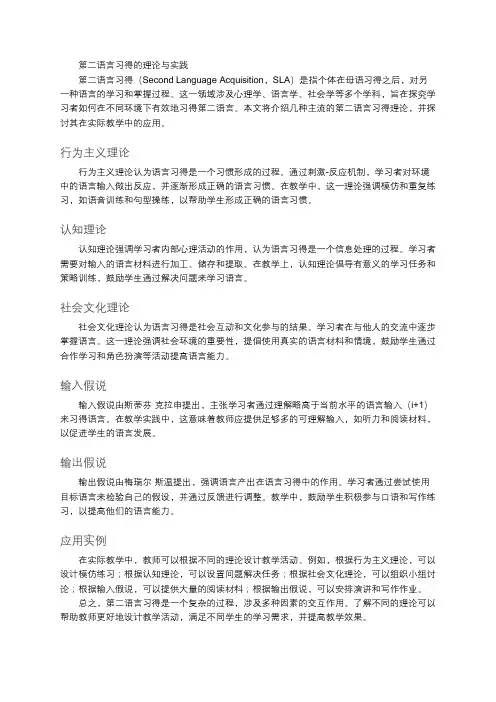
第二语言习得的理论与实践第二语言习得(Second Language Acquisition,SLA)是指个体在母语习得之后,对另一种语言的学习和掌握过程。
这一领域涉及心理学、语言学、社会学等多个学科,旨在探究学习者如何在不同环境下有效地习得第二语言。
本文将介绍几种主流的第二语言习得理论,并探讨其在实际教学中的应用。
行为主义理论行为主义理论认为语言习得是一个习惯形成的过程。
通过刺激-反应机制,学习者对环境中的语言输入做出反应,并逐渐形成正确的语言习惯。
在教学中,这一理论强调模仿和重复练习,如语音训练和句型操练,以帮助学生形成正确的语言习惯。
认知理论认知理论强调学习者内部心理活动的作用,认为语言习得是一个信息处理的过程。
学习者需要对输入的语言材料进行加工、储存和提取。
在教学上,认知理论倡导有意义的学习任务和策略训练,鼓励学生通过解决问题来学习语言。
社会文化理论社会文化理论认为语言习得是社会互动和文化参与的结果。
学习者在与他人的交流中逐步掌握语言。
这一理论强调社会环境的重要性,提倡使用真实的语言材料和情境,鼓励学生通过合作学习和角色扮演等活动提高语言能力。
输入假说输入假说由斯蒂芬·克拉申提出,主张学习者通过理解略高于当前水平的语言输入(i+1)来习得语言。
在教学实践中,这意味着教师应提供足够多的可理解输入,如听力和阅读材料,以促进学生的语言发展。
输出假说输出假说由梅瑞尔·斯温提出,强调语言产出在语言习得中的作用。
学习者通过尝试使用目标语言来检验自己的假设,并通过反馈进行调整。
教学中,鼓励学生积极参与口语和写作练习,以提高他们的语言能力。
应用实例在实际教学中,教师可以根据不同的理论设计教学活动。
例如,根据行为主义理论,可以设计模仿练习;根据认知理论,可以设置问题解决任务;根据社会文化理论,可以组织小组讨论;根据输入假说,可以提供大量的阅读材料;根据输出假说,可以安排演讲和写作作业。

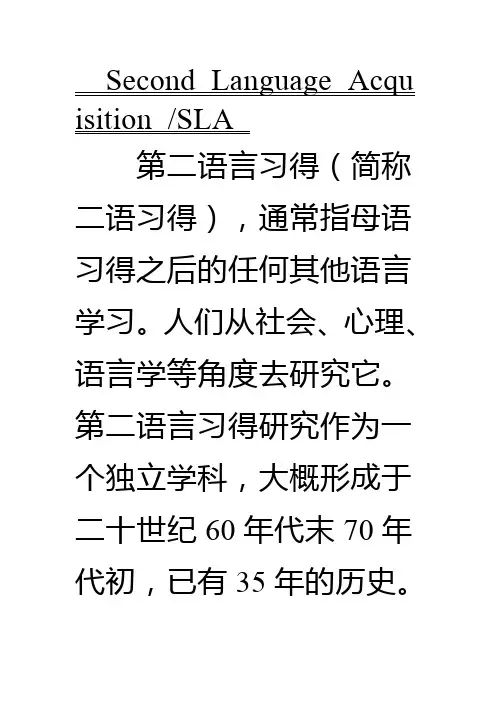
Second Language Acqu isition /SLA第二语言习得(简称二语习得),通常指母语习得之后的任何其他语言学习。
人们从社会、心理、语言学等角度去研究它。
第二语言习得研究作为一个独立学科,大概形成于二十世纪60年代末70年代初,已有35年的历史。
它对学习者的第二语言特征及其发展变化、学习者学习第二外语时所具有的共同特征和个别差异进行描写,并分析影响二语习得的内部因素和外部因素。
与其他社会科学相比,二语习得研究是个新领域,大都借用母语研究、教育学研究或其他相关学科的方法。
概括地说,这一领域的研究是为了系统地探讨二语习得的本质和习得的过程,其主要目标是:描述学习者如何获得第二语言以及解释为什么学习者能够获得第二语言。
到目前为止,二语习得的研究范围远比20世纪七八十年代广,涉及语言学、心理学、心理语言学、语用学,社会语言学等众多方面。
早期的第二语言习得理论是教学法的附庸,为服务提高教学质量而存在,1967年Larry Selinke r在《语言迁移》这本专著第一次提出中介语理论,第二语言习得理论从此有了自己的研究领域而开始成为一门独立的学科。
现时的第二语言习得研究涉及三大领域,即中介语研究,学习者内部因素研究和学习者外部因素研究。
1994年美国费城Temple 大学教育学院二语英语教学教授Rod Ellis撰写巨著《第二语言习得研究》,成为该领域的经典教科书。
该书共分七个部分。
第一部分勾画了整本书的概念框架。
第二部分总结了有关学习者语言本质的主要理论,包括学习者错误,发展模式,语言变项和语用特征。
第三部分从外部因素解释第二语言的习得,主要阐述社会因素和输入/交互的作用。
第四部分从内部因素解释第二语言的习得,包括语言迁移、认知论解释和语言普遍性。
第五部分将讨论的重点从学习转移到学习者,论述了第二语言习得的个体差异和学习策略。
第六部分是关于课堂英语教学的论述,讨论了课堂交互和正规教学的有关理论。


SLA_二语习得重要问题总结SLA期末考试提纲Week 9Chapter 1 In troduc ing Second Lan guage Acquisiti onChapter 2 Foun dati ons of Second Lan guage Acquisiti onPART ONE: Defi ni tio n:1. Second Language Acquisition (SLA): a term that refers both to the study of individuals andgroups who are lear ning a Ian guage subseque nt to lear ning their first one as young childre n, and to the process of lear ning that Ian guage.2. Formal L2 learning: instructed learning that takes place in classrooms.3. In formal L2 lear ning: SLA that takes place in n aturalistic con texts.4. First Ianguage/native Ianguage/mother tongue (L1): A Ianguage that is acquired naturally inearly childhood, usually because it is the primary Ianguage of a childwho grows up in a multilingual setting may have more than one “first ” Ianguage.5. Second Ianguage (L2): In its general sense, this term refers to any Ianguage that is acquiredafter the first Ianguage has been established. In its specific sense, this term typically refers to an additi onal Ian guage which is lear ned with in a con text where it is societally dominant and needed for education, employment, and other basic purposes. The more specific sense con trasts with foreig n Ian guage, library Ian guage, auxiliary (帮助的,辅助的)Ianguage, and Ianguage for specific purposes.6. Target Ianguage: The Ianguage that is the aim or goal of learning.7. Foreign Ianguage: A second Ianguage that is not widely used in the learnerssocial con text, but rather one that might be used for future travel or other cross-cultural com muni cati on situati ons, or one that might be studied as a curricular requireme nt or elective in school with no immediate or necessary practical application.8. Library Ianguage: A second Ianguage that functions as a tool for further learning,especially when books and journals in a desired field of study are not commonly published in the learner ' s L1.9. Auxiliary Ianguage A second Ianguage that learners need to know for some official functionsin their immediate sociopolitical setting. Or that they will need for purposes of wider com muni catio n, although their first Ian guage serves most other n eeds in their lives.10. L i nguistic compete nee: The un derly ing kno wledge that speakers/hearershave of a Ianguage. Chomsky dist in guishes this from lin guistic performa nee.11. Li nguistic performa nee: The use of Ian guage kno wledge in actual producti on.12. C ommunicative competence: A basic tenet (原则、信条、教条) of sociolinguistics defined as“ whata speaker needs to know to communicate appropriately within a particular language community Saville”-Tr(oike 2003)13. P ragmatic competence: Knowledge that people must have in order to interpret and conveymeaning within communicative situations.14. M ultilingualism: The ability to use more than one language.15. M onolingualism: The ability to use only one language.16.Simultaneous multilingualism: Ability to use more than one language that were acquiredduring early childhood.17.Sequential multilingualism: Ability to use one or more languages that were learned after L1had already been established.18.I nnate capacity:A natural ability, usually referring to children ' s natural abilityacquire language.19.Child grammar: Grammar of children at different maturational levels that is systematic interms of production and comprehension.20.Initial state: The starting point for language acquisition; it is thought to include the underlyingknowledge about language structures and principles that are in learners at the very start of L1 or L2 acquisition.21.I ntermediate state: It includes the maturational changes which take place in “ childgrammar ” , and the L2 developmental sequence which is known as learner language.22. F inal state: The outcome of L1 and L2 leaning, also known as the stable state of adultgrammar.23. Positive transfer: Appropriate incorporation of an L1 structure or rule in L2 structure.24. N egative transfer: Inappropriate influence of an L1 structure or rule on L2 use. Also calledinterference.25. P overty-of-the-stimulus: The argument that because language input to children isimpoverished and they still acquire L1, there must be an innate capacity for L1 acquisition.26.Structuralism: The dominant linguistic model of the 1950s, which emphasized the descriptionof different levels of production in speech.27.Phonology: The sound systems of different languages and the study of such systemsgenerally.28.Syntax: The linguistic system of grammatical relationships of words within sentences, such asordering and agreement.29.Semantics: The linguistic study of meaning.30. Lexicon: The component of language that is concerned with words and their meanings.31. B ehaviorism: The most influential cognitive framework applied to language learning in the1950s. It claims that learning is the result of habit formation.32. A udiolingual method: An approach to language teaching that emphasizes repetition and habitformation. This approach was widely practiced in much of the world until at least the 1980s.33. T ransformational-Generative Grammar: The first linguistic framework with an internal focus,which revolutionized linguistic theory and had profound effect on both the study of first and second languages. Chomsky argued effectively that the behaviorist theory of languageacquisition is wrong because it cannot explain the creative aspects of linguistic ability.Instead, humans must have some innate capacity for language.34. P rinciples and Parameters (model): The internally focused linguistic framework that followedChomsky T'rasnsformational-Generative Grammar. It revised specifications of whatconstitutes innate capacity to include more abstract notions of general principles andconstraints common to human language as part of a Universal Grammar.35. M inimalist program: The internally focused linguistic framework that followed Chomsky' Psrinciples and Parameters model. This framework adds distinctions between lexical andfunctional category development, as well as more emphasis on the acquisition of feature specification as a part of lexical knowledge.36. F unctionalism: A linguistic framework with an external focus that dates back to the earlytwentieth century and has its roots in the Prague School布拉格学派)of Eastern Europe.It emphasizes the information content of utterances and considers language primarily as a system of communication. Functionalist approaches have largely dominated European study of SLA and are widely followed elsewhere in the world.37. N eurolinguistics: The study of the location and representation of language in the brain, ofinterest to biologists and psychologists since the nineteenth century and one of the first fields to influence cognitive perspectives on SLA when systematic study began in 1960s.38. C ritical period: The limited number of years during which normal L1 acquisition is possible.39. C ritical Period Hypothesis: The claim that children have only a limited number of years duringwhich they can acquire their L1 flawlessly; if they suffered brain damage to the language areas, brain plasticity in childhood would allow other areas of the brain to take over thelanguage functions of the damaged areas, but beyond a certain age, normal languagedevelopment would not be possible. This concept is commonly extended to SLA as well, in the claim that only children are likely to achieve native or near-native proficiency in L2.rmation processing (IP): A cognitive framework which assumes that SLA (like learning ofother complex domains) proceeds from controlled to automatic processing and involves progressive reorganization of knowledge.41. C onnectionism: A cognitive framework for explaining learning processes,beginning in the1980s and becoming increasingly influential. It assumes that SLA results from increasing strength of associations between stimuli and responses.42. V ariation theory: A microsocial framework applied to SLA that explores systematic differences in lear ner producti on which depe nd on con texts of use.43. A ccommodatio n theory: A framework for study of SLA that is based on the no ti on thatspeakers usually unconsciously change their pronunciation and even the grammaticalcomplexity of senten ces they use to sound more like whomever they are talki ng to.44.Sociocultural theory (SCT): An approach established by Vygotsky which claims thatinteraction not only facilitates Ianguage learning but is a causative force in acquisition.Further, all of learning is seen as essentially a social process which is grounded insociocultural sett in gs.45. E th no graphy(人种论、民族志)of com muni catio n: A framework for an alysis of Ianguageand its functions that was established by Hymes(1966). It relates Ianguage use to broader social and cultural con texts, and applies eth no graphic methods of data collecti on and in terpretati on to study of Ian guage acquisiti on and use.46. A cculturation(文化适应):Learning the culture of the L2 community and adapting to thosevalues and behavior patter ns.47. Acculturati on Model/Theory: Schuma nn 's (1978) theory thOfeideotip factors suchas ide ntity and status which determ ine social and psychological dista nee betwee n lear ner and target Ian guage populati ons. He claims these in flue nee outcomes of SLA.48.Social psychology: A societal approach in research and theory that allows exploratio n ofissues such as how ide ntity, status, and values in flue nce L2 outcomes and why. It has disciplinary ties to both psychological and social perspectives.PART TWO: Short & Long an swers:Chapter 11. What are the similarities and differences between linguists, psycholinguist, socioli nguists andsocial psycholi nguists? P3(1)Linguists emphasize the characteristics of the differences and similarities in the Ianguages that are being lear ned, and the lin guistic compete nce (un derly ing kno wledge) and lin guistic performa nce (actual producti on) of lear ners at various stages of acquisiti on.(2)Psychologists emphasize the mental or cognitive processes invoIved in acquisition, andthe represe ntatio n of Ian guages in the brain.(3)Sociolinguists emphasize variability in learner linguistic performance , and extend thescope of study to com muni cative compete nceun derly ing kno wledge that additi on ally acco unts for Ian guage use, or pragmatic compete nce).(4)Social psychologists emphasize group-related phenomena, such as identity and socialmotivatio n, and the in teractio nal and larger social con texts of lear ning.2. What are the differences between second language, foreign language, librarylanguage and auxiliary language? P4(1)A second language is typically an official or societally dominant language needed for education, employment, and other basic purposes. It is often acquired by minority group members or immigrants who speak another language natively. In this more restricted sense, the term is contrasted with other terms in this list.(2)A foreign language is one not widely used in the learners' immediate social context which might be used for future travel or other cross-cultural communication situations, or studied as a curricular requirement or elective in school, but with no immediate or necessary practical application.(3)A library language is one which functions primarily as a tool for future learning through reading, especially when books or journals in a desired field of study are not commonlypublished in the learners' native tongue.( 4 )An auxiliary language is one which learners need to know for some official functions in their immediate political setting, or will need for purposes of wider communication, although their first language serves most other needs in their lives.3. Why are some learners more (or less) successful than other? P5The intriguing question of why some L2 learners are more successful than others requires us to unpack the broad label “ learners ” for some dimensions ofudisitsi c sussion.Linmay distinguish categories of learners defined by the identity and relationship of their L1 and L2; psycholinguists may make distinctions based on individual aptitude for L2 learning,personality factors, types and strength of motivation, and different learning strategies;sociolinguists may distinguish among learners with regard to social, economic, and political differences and learner experiences in negotiated interaction; and social psychologists may categorize learners according to aspects of their group identity and attitudes toward target language speakers or toward L2 learning itself.Chapter21. List at least five possible motivations for learning a second language at an older age.P10The motivation may arise from a variety of conditions, including the following: Invasion or conquest of one ' s country by speakers of another language;A need or desire to contact speakers of other languages in economic or other specificdomains;Immigration to a country where use of a language other than one's L1 is required;Adoption of religious beliefs and practices which involve use of another language;A need or desire to pursue educational experiences where access requires proficiency inanother language;A desire for occupational or social advancement which is furthered by knowledge ofanother language;An interest in knowing more about peoples of other cultures and having access to theirtechnologies or literatures.2. What are the two main factors that influence the language learning? P13(1)The role of natural ability: Humans are born with a natural ability or innate capacity to learn language.(2)The role of social experience: Not all of L1 acquisition can be attributed to innate ability, for language-specific learning also plays a crucial role. Even if the universal properties of language are preprogrammed in children, they must learn all of those features whichdistinguish their L1 from all other possible human languages. Children will never acquire such language-specific knowledge unless that language is used with them and around them, and they will learn to use only the language(s) used around them, no matter what theirlinguistic heritage. American-born children of Korean or Greek ancestry will never learn the language of their grandparentsif only English surrounds them, for instance, and they will find their ancestral language just as hard to learn as any other English speakers do if they attempt to learn it as an adult. Appropriate social experience, including L1 input and interaction, is thus a necessary condition for acquisition.3. What is the initial state of language development for L1 and L2 respectively? P17-18The initial state of L1 learning is composed solely of an innate capacity for languageacquisition which may or may not continue to be available for L2, or may be available only in some limited ways. The initial state for L2 learning, on the other hand, has resources of L1 competence, world knowledge, and established skills for interaction, which can be both an asset and an impediment.4. How does intermediate states process? P18-19The cross-linguistic influence, or transfer of prior knowledge from L1 to L2, is one of theprocessesthat is involved in interlanguage development. Two major types of transfer which occur are: (1) positive transfer, when an L1 structure or rule is used in an L2 utterance and that use is appropriate or “ correct ” in the L2; and (2) negativ interference), when an L1 structure or rule is used in an L2 utterance and that use isinappropriate and considered an“ error ”.5. What is a necessary condition for language learning (L1 or L2)? P20Language input to the learner is absolutely necessary for either L1 or L2 learning to take place. Children additionally require interaction with other people for L1 learning to occur. It is possible for some individuals to reach a fairly high level of proficiency in L2 even if they have input only from such generally non-reciprocal sources as radio, television, or written text.6. What is a facilitating condition for language learning? P20While L1 learning by children occurs without instruction, and while the rate of L1 development is not significantly influenced by correction of immature forms or by degree of motivation to speak, both rate and ultimate level of development in L2 can be facilitated or inhabited by many social and individual factors, such as (1) feedback, including correction of L2 learners' errors; (2) aptitude, including memory capacity and analytic ability; (3) motivation, or need and desire to learn; (4) instruction, or explicit teaching in school settings.7. Give at least 2 reasons that many scientists believe in some innate capacity for language.P21-24The no ti on that inn ate lin guistic kno wledge must un derlie (指原贝卩、理由构成某学说...的基础,潜在于…之下)language acquisition was prominently espoused采纟纳或支持事业理念)by Noam Chomsky. This view has been supported by arguments such as thefollowing:(1)Children 's knowledge of language goes beyond what could be learned from the input theyreceive: Children often hear incomplete or ungrammatical utterances along withgrammatical input, and yet they are somehow able to filter the language they hear so that the ungrammatical input is not incorporated into their L1 system. Further, children arecommonly recipients of simplified input from adults, which does not include data for all of the complexities which are within their linguistic competence. In addition, children hearonly a finite subset of possible grammatical sentences, and yet they are able to abstract general principles and constraints which allow them to interpret and produce an infinitenumber of sentences which they have never heard before.(2) Constraints and principles cannot be learned: Children 's access to generaland principles which govern language could account for the relatively short time it takes for the L1 grammar to emerge, and for the fact that it does so systematically and without any “wild d”ivergences. This could be so because innate principles lead children to organize the input they receive only in certain ways and not others. In addition to the lack ofnegative evidence , constraints and principles cannot be learnt in part because childrenacquire a first language at an age when such abstractions are beyond theircomprehension; constraints and principles are thus outside the realm of learning process which are related to general intelligence.(3) Universal patterns of development cannot be explained by language-specific input: In spiteof the surface differences in input, there are similar patterns in child acquisition of anylanguage in the world. The extent of this similarity suggests that language universals are not only constructs derived from sophisticated theories and analyses by linguists, but also innate representations in every young child 's min8. Linguists have taken an internal and/or external focus to the study of language acquisition.What is the difference between the two? P25-26Internal focus emphasizes that children begin with an innate capacity which is biologically endowed, as well as the acquisition of feature specification as a part of lexical knowledge;while external focus emphasizes the information content of utterances, and considerslanguage primarily as a system of communication.9. What are the two main factors for learning process in the study of SLA from apsychological perspective? P26-27(1) In formatio n Process in g,which assumesthat L2 is a highly complex skill, and thatlearning L2 is not essentially unlike learning other highly complex skills. Processing itself is believed to cause lear ning;(2) Conn ecti oni sm, which does not con sider Ian guage lear ning to inv olve either inn ateknowledge or abstraction of rules and principles, but rather to result from increasing stre ngth of associati ons (conn ecti ons) betwee n stimuli and resp on ses.10. What are the two foci for the study of SLA from the social perspective? P27(1) Microsocial focus: the concerns within the microsocial focus relate to Ianguage acquisition and use in immediate social con texts of producti on, in terpretati on, and in teractio n. (2) Macrosocial focus: the concerns of the macrosocial focus relate Ian guage acquisiti on and use to broader ecological con texts, in cludi ng cultural, political, and educati onal sett in gs.Week10Chapter 5 Social con texts of Second Lan guage Acquisiti onPART ONE: Defini tio n1. Com mun icative compete nee: A basic tenet of socioli nguistics defi ned as“ wn eeds to know to com muni cate appropriately withi n a particular Ian guagecommunity ” (Savi-leroike 2003)2. Lan guage com muni ty: A group of people who share kno wledge of a com mon Ian guage toat least some exte nt.3. Foreigner talk: Speech from L1 speakers addressed to L2 learners that differs insystematic ways from Ian guage addressed to n ative or very flue nt speakers.4. Direct Correcti on: Explicit stateme nts about in correct Ian guage use.5. In direct correcti on: Implicit feedback about in appropriate Ian guage use, such asclarification requests when the listener has actually understood an utteranee.6. Interaction Hypothesis: The claim that modifications and collaborative efforts which takeplace in social in terati on facilitate SLA becausethey con tribute to the accessibility ofinput for mental processing.7. Symbolic mediation: A link between a person 'csurrent mental state and higher orderfunctions that is provided primarily by language; considered the usual route to learning (of language, and of learning in general). Part of Vygosky ' s Sociocultura8. Variable features: Multiple linguistic forms (vocabulary, phonology, morphology, syntax,discourse) that are systematically or predictably used by different speakers of a language, or by the same speakers at different times, with the same meaning or function.9. Linguistic context: Elements of language form and function associated with the variableelement.10. P sychological context: factors associatedwith the amount of attention which is being given tolanguage form during production, the level of automaticity versus control in processing, or the intellectual demands of a particular task.11. M icrosocial context: features of setting/situation and interaction which relate tocommunicative events within which language is being produced, interpreted, and negotiated.12. A ccommodation theory: A framework for study of SLA that is based on the notion thatspeakers usually unconsciously change their pronunciation and even the grammaticalcomplexity of sentences they use to sound more like whomever they are talking to .13. Z PD: Zone of Proximal Development, an area of potential development where the learner canonly achieve that potential with assistance. Prat of Vygosky ' s Sociocultural Theory.14.Scaffolding: Verbal guidance which an expert provides to help a learner perform any specifictask, or the verbal collaboration of peers to perform a task which would be too difficult for any one of them in individual performance.15.I ntrapersonal interaction: communication that occurs within an individual's own mind,viewed by Vygosky as a sociocultural phe nomen.16」n terpers onal in teractio n: Communi cative eve nts and situatio ns that occur betwee n people.17.Social institutions:The systems which are established by law, custom, or practice to regulateand organize the life of people in public domains: e.g. politics, religion, and educati on.18. Acculturation: learning the culture of the L2 community and adapting to those values andbehavioral patter ns.19. Additive bili ngualism: The result of SLA in social con texts where members of a dominantgroup learn the Ianguage of a minority without threat to their L1 competence or to their ethnic identity.2O.Subtractive bili ngualism: The result of SLA in social con texts where members of a minority group learn the dominant Ianguage as L2 and are more likely to experience some loss of ethnic identity and attrition of L1 skills —especially if they are children.21.Formal L2 learni ng: formal/i nstructed lear ning gen erally takes place in schools, which aresocial institutions that are established in accord with the needs, beliefs, values, and customs of their cultural sett in gs.22」n formal L2 lear ning: in formal/naturalistic lear ning gen erally takes place in sett ings where people con tac—a nd n eed to in teract with— speakers of ano ther Ian guage.PART TWO: Short & Long an swers1. what is the differe nce betwee n mono li ngual and multil in gual com muni cative competence?Differe ncese betwee n mon oli ngual and multili ngual com muni cative compete nce are due in part to the different social functions of first and second Ianguage learning, and to the differe nces betwee n lear ning Ian guage and lear ning culture.The differences of the competence between native speakers and nonative speakers include structural differences in the linguisitc system, different rules for usage in writing or conversation, and even somewhat divergent meanings for the “ same” lexical f a multilingual speaker ' s total communicative competence diffeartsofrfoammtohnolingual in including knowledge of rules for the appropriate choice of language and for switching betweenlanguages, given a particular social context and communicative purpose.2. what are the microsocial factors that affect SLA? P101-102a) L2 variation b) input and interaction c) interaction as the genesis of language3. What is the difference between linguistic & communicative competence (CC)?Linguistic competence- It was defined in 1965 by Chomsky as a speaker's underlying ability to produce grammatically correct expressions. Linguistic competence refers to knowledge of language. Theoretical linguistics primarily studies linguistic competence: knowledge of a language possessed by “an ide-alisl tsepneeark ”.Communicative competence- It is a term in linguisticswhich refers to “ what a speaker need to know to communicate appropriately within a particular language community language user's grammatical knowledge of syntax , morphology , phonology and the like, as well as social knowledge about how and when to use utterances appropriately.4. Why is CC in L1 different from L2?L1 learning for children is an integral part of their sociolization into their native language community. L2 learning may be part of second culture learning and adaptation, but the relationship of SLA to social and cultural learning differs greatly with circumstances.5. What is Accommodation Theory? How does this explain L2 variation?Accommodation theory: Speakers (usually unconsciously) change their pronunciation and even the grammatical complexity of sentences they use to sound more like whomever they are talking to. This accounts in part for why native speakers tend to simply their language when they are talking to a L2 learner who is not fluent, and why L2 learners may acquire somewhat differentvarieties of the target language when they have different friends.6. Discuss the importance of input & interaction for L2 learning. How could this affect thefeedback provided to students?i . a) From the perspective of lin guistic approaches: (1) behaviorist: they con sider in put to form the necessary stimuli and feedback which learners respond to and imitate; (2) Universal Grammar: they consider exposure to input a necessary trigger for activating internal mechanisms; (3) Monitor Model: consider comprehensible input not only necessary but sufficient in itself to account for SLA;b) From the perspective of psychological approaches: (1) IP framework: consider input which is attended to as essential data for all stages of language processing; (2) connectionist framework: consider the quantity or frequency of input structures to largely determine acquisitional sequencing;c) From the perspective of social approaches: interaction is generally seen as essential in providing learners with the quantity and quality of external linguistic input which is required for internal processing.ii . Other types of interaction which can enhance SLA include feedback from NSs which makes NNs aware that their usage is not acceptable in some way, and which provides a model for“ correctness ” . While children rarely receive such negative evidence in L1, and don' t require it to achieve full native competence, corrective feedback is common in L2 and may indeed be necessary for most learners to ultimately reach native-like levels of proficiency when that is the desired goal.7. Explain ZPD. How would scaffolding put a student in ZPD?。
⼆语习得复习提纲Chapter I Introduction Describing and Explaining L2 Acquisition 1.1What is second language acquisition?Second language refers to any language that is learned subsequent to the mother tongue.1.2What are the goals of second language?The goals of SLA are to describe how L2 acquisition proceeds and to explain this process and why some learners seem to be better at it than others.1.3Two case studies of L2 learners1.3.1 A case study of an adult learner1.3.2 A case study of two child learnersWhat do these case studies show us?a. They raise a number of important methodological issues relating to how L2 acquisition should be studiedb. They raise issues relating to the description of learner languagec. They point out some of the problems researchers experience in trying to explain L2 acquisition.1.4Methodological issuesWhat is that needs to be described?a. What it means to say that a learner has acquired a feature of the target language?b. Whether learners have acquired a particular feature?c. How to measure whether acquisition has taken place? (Learner’s overuse of linguistic forms.)1.5Issues in the description of learner languagea. Learners make errors of different kinds.b. Learners acquired a large number of formulaic chunks, which will influence their performancein communication and the fluency of their unplanned speech.c. Whether learners acquire the language systematically?1.6Issues in the explanation of L2 acquisitionItem learning: formulaic chunksSystem learning: rulesInternal (mentalist) account:External account:Chapter2 the Nature of Learner Language2.1Errors and error analysis2.1.1 Identifying errors2.1.1.1 Compare the learner’s language with the normal ones.2.1.1.2 Distinguish errors and mistakes.Definition: Errors reflect gaps in a learner’s knowledgeMistakes reflect occasional lapses in performance.Methods: a. Check the consistency of learners’ performance.b. Ask them to correct their own utterance.Errors and mistakes:2.1.2 Describing errorsMethods: a. error type oriented:b. error maker oriented:Meaning: Classifying errors in these ways can help us to diagnose learners’learning problems at any one stage of their development and, also to plot how changes in error patterns occur over time.2.1.3 Explaining errorsErrors are systematic, predictable, and some of them are universal: (Learners has constructed some kind of “rule”, albeit a rule different from that of the target language)Eg: omission: leave out the article “the”, leave out the –s in plural nouns Overgeneralization error: eated---ateTransfer errors reflect learners attempt to make use of their L1 knowledge.2.1.4 Error evaluationTypes of errors: Global errors: violate the whole structure of the sentenceLocal errors: affect only a single constituent in the sentence2.2Developmental patterns2.2.1 The early stage of L2 acquisitionSilent period: children make no attempt to say anything to begin with.This period makes a preparation for subsequent production.Trials and errors: Mulaic chunks: they provide learners with the means of performing usefullanguage functions such as greetings and requests.Eg:“How do you do?”“My name is___”Propositional simplification: leave words outEg: “Me no blue”2.2.2 The order of acquisitionAccuracy order: there is a definite accuracy order and that this remains more or less the same irrespective of the learner’s mother tongues, age, and whether or not they have receive formal language instruction.2.2.3 Sequence of acquisitiona. The acquisition of a particular grammatical structure, therefore, must be seen as a process involving transitional constructions.b. Acquisition follows a U shaped course of development.c. The process in which learners reorganize their existing knowledge in order to accommodate new knowledge is called restructuring.2.2.4 Some Implicationsa. L2 is systematic and universal, reflecting ways in which internal cognitive mechanisms control acquisition, irrespective of the personal background of learners or the settings in which they learn.b. Some linguistic features are inherently easier to learn than others.2.3Variability in learner languagea. Variability is also systematic, that is, learners use their linguistic sources in predictable ways.b. Learners vary in their use of the second language according tolinguistic context (George playing football/ ..all the time)situational context.(kids/daughter)& psycholinguistic context (prepared/unprepared)c. form-function mappingd. free variation:e. fossilization:⽯化成因任何现象的出现都不是偶然的,是可以追溯出它的原因的,⼆语习得过程中出现的中介语⽯化现象也是有着根本性的原因的。
二语习得复习资料第一章(填空+名词解释)第一节第二语言习得的基本概念母语:通常指的是学习者幼年习得的语言。
由于母语是家庭或者所属种族、社团使用的语言,因而也称作“本族语”。
一般说来,母语通常是儿童出生以后最先接触、学会的语言。
因此,母语通常也被称作“第一语言”。
目的语:也称“目标语”,一般是指学习者正在学习的语言。
第一语言:指儿童幼年最先接触和习得的语言。
第二语言强调的是语言习得的先后顺序,与语言习得环境无关。
“习得”是一种下意识、非正式的类似儿童母语的获得过程。
学习者通常意识不到他们正在学习语言这一事实,但是能意识到他们正在用语言进行交际。
“学习”是指有意识地、正式的学习语言知识,能够明确地意识到所学的规则。
克拉申把这两个方式看作彼此独立的学习过程。
无接口观点、有接口的观点“第二语言习得”是指学习者在目的语国家学习目的语。
该目的语在目的语国家是公认的交际工具,当然也是学习者用来交际的工具。
“外语习得”是指学习者在本国学习目的语。
该目的语在本国不是作为整个社团的交际工具。
“自然的第二语言习得”是指以交际的方式获得第二语言,而且语言习得通常是在自然的社会环境下发生的。
“有指导的第二语言习得”是以教学指导的方式获得第二语言,语言习得通常是在课堂教学环境中发生的。
“语言能力”美国语言学家乔姆斯基首先提出了“语言能力”的概念。
其含义是,人类先天具有的、受遗传因素决定的掌握语言规则的能力。
这里所说的语言能力是指人们掌握语言知识的能力。
“语言表达”——在实际生活中运用语言进行社会交往的能力。
美国社会语言学家海姆斯第一次提出交际能力的概念,它包括四个方面的内容:语法性、可行性、得体性、现实性。
第三节第二语言习得发端发展简要回顾1.第二语言习得研究作为一门独立的学科是以1967年S.P.Corder(科德)发表的颇具影响的论文《学习者偏误的意义》以及1972年Selinker(塞林格)的《中介语》为标志。
2.第二语言习得研究发展历程:第一阶段:20世纪50—60年代对比分析第二阶段:70年代“中介语”理论第二语言习得顺序“监控模式”文化适应模式第三阶段:80年代中期至今受多学科影响第二章第一节对比分析1.对比分析,是通过对第二语言学习者母语与目的语在语音、词汇、语法等方面的系统对比,找出两者之间的异同,从而预测第二语言学习者可能遇到的语言困难和可能产生的语言错误,进而采取一定的教学手段,以达到教学中避免或减少第二语言学习者的错误的目的。
1.Definition of Second language acquisition:It refers to a systematic study of how one person acquires a second language subsequent to his native language.Acquisition习得: 无意识地学会Learning学习:通过系统学习语法规律等学会2.Interlanguage 中介语Selinker (1972) coined the term “interlanguage” to refer to the systematic knowledge of an L2 which is independent of both these learners’ L1 and the target language. The term has come to be used with different but related meanings: (1) to refer to the series of interlocking systems which characterize acquisition. (2) to refer to the system that is observed at a single stage of development. (“interlanguage”), and (3) to refer to particular L1/L2 combination (for example,L1 French/ L2 English v. L1 Japanese/L2 English). Other terms that refer to the same basic idea are “approximative system” and “transitional competence”.定义:中介语:中介语理论假设第二语言学习者有一个自行创造的独特的语言系统,介乎学习者的母语和目的语之间,并随学习的进展逐渐向目的语靠拢。
因为游离于母语和目的语之间,中介语自然包含许多错误。
E.g. I lost my road.I lost my way.特征:Fossilization(石化现象):It refers to the phenomenon that incorrect linguistic features become a permanent part of the way a person speaks or writes a language.石化现象是中介语的重要特征E.g. All students are not here.不是所有的学生都在这里None of the student is here.所有的学生都不在这里FossilizationSelinker (1972) noted that most L2 learners fail to reach target-language competence. That is, they stop learning while their internalized rule system contains rules different from those of target system. This is referred to as “fossilization”. It reflects the operation of various internal processes.一、Concepts of Second language acquisition:1.Objectives:①Competence vs performance②L1 vs. L2 vs. FL③Acquisition vs. learning④Input vs. output⑤Interlanguage 中介语⑥Variability⑦Fossilization (石化现象)⑧Language transfer 迁移2. Competence vs. PerformanceChomsky (1957)made his famous distinguish between Competence and PerformanceCompetence: an ideal speaker’s knowledge of his languages manifested in his ability to usethe language.Sound, form, meaning:Performance:the specific utterances, including grammatical mistakes and non-linguistic features such as hesitations, etc.✧Competence and performance in language learningWhat is acquired or learned of the two?✧In language learning, what does the distinction tell us? (result, process, evaluation)3.First language vs. Second language vs. F L1.What is First language (L1)?L1, with other names: native language (NL), mother tongue, primary language. First language or second language indicates the order or sequence of language learning.2. What is second language (L2)?The language one learns after his native language or L1.“Second”can mean any language one learn that is subsequent to his L1.3.Two senses of L2A: the language one learns after his native language, one learns the language in the target language (TL) language environment. (narrow sense)Example: A Chinese learns English in US or UK. An American learns Chinese in China.B: Any language that one learns other than his native tongue.( broad sense)Example: We are learning English in China.4.Foreign Language (FL)The language that one learns other than his first language, but not in the target language environment.①Learning English not in the English-spoken countries.②Differences between FL and L2FL L24.A Comparison between L1 and L2 acquisitionSpeedStagesError correctionDepth of knowledgeSuccessLevel of attainment5.Acquisition vs. Learning1. What is acquisition?The distinction between acquisition and learning was made by S. Krashen, the famous American applied linguist in his “Monitor Theory”.He defined two types of modes of learning in adult L2 learning.2.Acquisition: the subconscious learning process in the natural language environment that is not influenced by explicit instruction in a second language’s rules and system or about errors.Learning: is a conscious process of language development that is the result of intended and explicit instruction in a second language’s roles and system or about errors in a artificial environment such as a formal language classroom.A comparison between Learning and acquisition6.Input and Output①What is input and output?Generally, input refers to the channels (process) that learners acquire information of language in learning or acquisition: listening and reading;Output refers to the channels and process results) that learners produce language, including speaking and writing.②Kinds of InputAuthentic input:Native speaker input, no modificationModified inputNative speaker input, no modificationInterlanguage inputTeacher talk, peers talk③Linguistic adjustments to Non-Native Speakers (NNS)“foreigner talk”( Ferguson, 1975)well-formed but modified.Feature* slower, more careful pronunciation, stress on key words (VOA special English)* shorter grammar structures* grammatical relations made explicit* less syntactic or propositional complexity* restricted vocabulary size* fewer pro forms④Comprehensible inputStephen Krashen (1981) held that learners acquire an L2 by hearing and understanding messages that are slightly above their current language L2 level. This type of input is called comprehensible input (namely, “i+1”)Essentially, comprehensible input is that bit of language that is heard/read and that is slightly ahead of a learner’s current state of grammatical knowledge.Language containing structures a learner already knows essentially serves no purpose in acquisition. Similarly, language containing structures ahead of a learner’s current knowledge is not useful.A learner does not have the ability to “do”anything with those structures.Krashen defined a learner’s current state of knowledge as i and the next stage as i + 1.Thus the input a learner is exposed to must be at the i + 1 level in order for it to be of use in terms of acquisition. “We move from i, our current level to i + 1, the next level along the natural order, by understanding input containing i + 1”(1985, p. 2).The teacher’s main role, then, is to ensure that students receive comprehensible input.⑤Comprehensible outputMany researchers believe that Input alone is not sufficient for acquisition, because when one hears language one can often interpret the meaning without the use of syntax.Input ----------------→output (what is in between?)Intake is very necessary for Second language learners also need comprehensible output: chances to practice their language. This practice is called comprehensible output.Cooperative learning is one effective way to do so.Comprehensible output refers to the need for a learner to be “pushed toward the delivery of a message that is not only conveyed, but that is conveyed precisely, coherently, and appropriately”(Swain, 1985, p. 249).Output, thus, would seem to have a potentially significant role in the development of syntax and morphology”(Swain, 1995, p. 128).可理解输入的三个功能:注意/触发功能(noticing)。